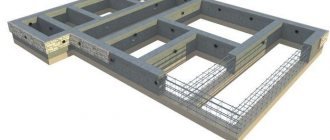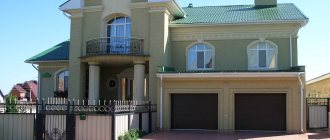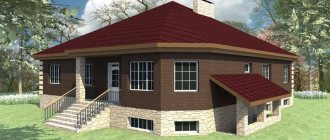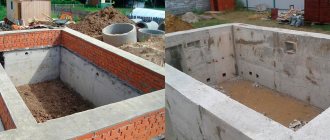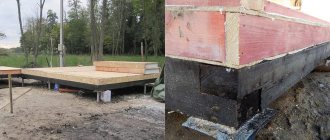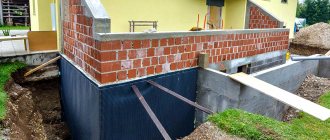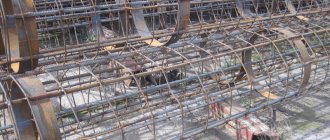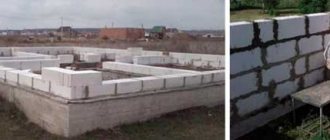The foundation is the supporting structure of a building. It evenly distributes the loads from the higher structure along the base. Even if you decide to build a house without a foundation, you cannot do without some preparation of the soil.
Having made the foundation under the house you:
- Evenly distribute the load from the building;
- Remove moisture from the basement floor;
- Reduce the likelihood of shrinkage and deformation of the structure (especially important for frame buildings);
- Improve the ventilation of the base (relevant if you are building a wooden house from timber).
Several centuries ago, people did not use concrete mortar (the modern version of concrete appeared only in 1844), therefore, an alternative was found to perform the basic functions of the foundation.
- A perfectly flat area is suitable for evenly distributing the load.
- To protect the base from moisture, you can use waterproofing.
- To reduce soil vibrations, you can use an elastic layer.
- To prevent rotting of the crowns, beams and lower blocks, you can treat them with a protective solution.
House without concrete foundation
The modern way of building houses involves the use of a variety of building parts, which have a direct impact on the quality of the building. One of these construction parts is considered to be the foundation for the building. However, concrete consistency was not used before centuries ago. Why then, today most people ask questions: is it possible to construct a house without a foundation or not?
The first thing you need to understand is why a foundation for a building is required. The main requirement of a concrete foundation is to withstand the enormous load of a heavy house. It ends up on the ground due to the bulky elements of the building's construction. This means that almost any flat plane will be a suitable option. This role can be performed by reliable waterproofing. The second important purpose of the foundation is resistance to deformation under the influence of soil heaving. This function can be well performed by an elastic layer of any kind. It will reliably dampen any soil vibrations.
The third function of the foundation is ventilation of the lower level of the building. Otherwise, you can safely discard it by resorting to the help of specialized solutions. By treating the first crowns of a wooden structure, this ensures reliable protection of the wooden material from rotting. In this regard, you can safely build a house without a foundation by replacing the usual concrete foundation with a flat and solid platform. In functionality, such a house will compete with classical types of construction.
An alternative to the foundation of a house
In order to construct a house without a foundation, it is necessary to replace the concrete foundation with an alternative one. For this you can use ordinary car tires. At the time of mounting the tires, timber is laid on some of them for strapping. This type of material is the most affordable, and such a base serves for a long time.
Having laid the car tires on the site around the perimeter of the future house, it is necessary to partially fill them with sand of any fraction. After which the filled sand is moistened and compacted, then the procedure is repeated. The stages are carried out until half the tire is filled.
Then you need to pour medium-sized crushed stone. The result will be identical in characteristics to an ordinary concrete base. The base, constructed from car tires, has the following advantages:
- Good shock-absorbing characteristics, due to this there is good protection against heaving in the ground
- The ecology of the structure is preserved
- A building with a typical foundation has good stability. Based on the large number of positive reviews from people who once used this type of foundation, we can conclude that distortions of load-bearing walls do not occur.
- The material is accessible to any buyer, unlike a concrete structure.
- It is possible to construct a foundation of this type without extensive experience in the construction industry.
Alternative to foundation
If you decide to do without a foundation, then you need to choose a foundation option that can perform the same tasks. These include the following types of grounds:
- using car tires;
- from hard rock boulders;
- from very dense soil;
- using gravel and sand.
Soil block base
This method of arranging the foundation for a house was used in the old days. Today, construction using this technology is also popular. You can make blocks from soil with your own hands in this way: pour soil into prepared forms and compact them thoroughly.
After the mold is removed, the soil block is allowed to dry thoroughly. Such blocks are used to assemble a base around the perimeter of the object on which the structure is installed.
Sand and gravel base
One of the most reliable ways to build a foundation without laying a classic supporting structure is a foundation pit. First, you should dig a pit one meter deep. Channels can be made at the bottom of the pit to provide a system for draining water. Then the pit is filled with gravel and sand. It is best if it is river sand with water.
After this, it is necessary to arrange waterproofing. To improve quality, you can fill the upper part of the pit with concrete. To do this, about 20 cm in the upper part of the pit is covered with large stones or laid out with bricks and filled with sand-cement mortar. The wooden frame of the future object is laid on the concrete surface.
Objects built on such a basis do not shrink, and cracks are completely eliminated.
Brick base
In cases where the soil is clayey to a sufficiently great depth and there is no groundwater, the foundation can be made using brickwork. High quality bricks should be used. The dimensions of the masonry at the base are about 140 cm, and at the level of the lower trim it can be reduced to 70 cm.
It is carried out along the boundaries of the future building and under load-bearing walls. To ensure reliability, brick masonry pillars can be placed throughout the site.
Tire base
You can hoist the object with your own hands on a base consisting of tires. This is one of the most affordable materials. It is able to withstand loads and last a long time. The bottom line is that the tires are laid out on the site in the shape of a figure corresponding to the plan of the future house.
Sand is gradually poured inside the tires, which is compacted and spilled with water. Sand is poured so that one quarter of the free space remains. The remaining voids are filled with gravel. A lower bundle of wooden beams is installed on top.
The base prepared in this way has the following characteristics:
- very good shock absorption, which can protect the object from seasonal soil fluctuations;
- the ability to prevent shrinkage and deformation of the structure;
- making such a base is very economical;
- ease of installation.
We recommend watching a video of how construction is done on a base made of tires.
Boulder base
If the construction of an object is carried out in an area rich in rocks or rock deposits, it is very convenient to make a foundation from boulders. Stone buildings have the property of high stability, as well as all the characteristics that a concrete foundation has. This foundation can be done in two ways:
- Large boulders should be installed in the corners and under the walls, which will serve as load-bearing walls. Then a pile with ventilation holes is formed from the boards and covered with small stones with sand or soil.
- They build a small channel, at the bottom of which large boulders are placed, then smaller boulders. Then the whole thing should be filled with concrete or compacted with sand and clay.
The advantages of such a base are its ability to last for many years and provide protection to the lower trim from moisture.
Watch a video on how to prepare stones for laying in a trench.
Foundation consisting of boulders
Installation of such a foundation is considered cheap only in construction in mountainous areas where rock elements, that is, boulders, can be found. Stages of constructing a rock foundation:
- The first step is to carry out marking work on the surface of the soil located at the construction site
- Boulders should be sorted by size, after which they should be stacked close to the construction site. Large stones should be placed in a separate pile, as they will be useful in the final arrangement.
- Installation work should begin with preparatory work, that is, with digging ditches. The largest boulders will be deposited at its bottom. Natural stones must be fastened together, otherwise the foundation will not work. For this purpose, a cement mortar or clay with medium sand is most often used.
- The frame beams of the structure are installed on top of large stones.
Upon completion of the installation work, a full-fledged base is obtained that is in no way inferior to the traditional version. Its characteristics exceed those of a concrete foundation in terms of strength and durability. During the period of soil heaving, the structure of the house is not subject to deformation, since the large weight of the stones dampens any manipulation.
Concrete blocks instead of a base
Blocks made from concrete are used as the basis for a building in several ways:
- Concrete blocks are installed in places of load-bearing walls, covering the entire length with indentations into the span. They are also installed around the perimeter of the building, that is, as with the usual laying of the base. The resulting joints must be laid using a solution made from a cement consistency. Before installation begins, trenches or holes should be dug. After this, a layer of sand cushion and a small amount of crushed stone is poured into them. Having finished laying the layer, it is necessary to compact it thoroughly. Roofing material must be laid on top. Only after this are concrete blocks installed.
- The hollow concrete block is laid in two rows. With their help, the supports are folded into a pair of concrete blocks. Installation is carried out at the corners of the building and along the perimeter of load-bearing walls. In another method, concrete masonry is installed with a height of 2 rows. One layer of roofing material is laid on top.
The first installation option is more expensive than the second because installation will require the help of a crane. The second method is considered more accessible and easier to install. Both options require a waterproofing process, for example: you can treat with bitumen and hide the flaws with finishing.
Screw base
Nowadays, the majority of people want to make a country house on their own, and choose wood for this. The fact is that this natural material used in construction is environmentally friendly. It is warm in winter, but not hot in summer. The cost of such construction is quite high, and you should not forget about the foundation on which the wooden house will be built. The cost, for example: a strip foundation is high, and there is a lot of earthwork. There are many disadvantages to the standard method of building a foundation, especially in winter. After laying the concrete foundation, it is necessary to wait time for shrinkage. Otherwise, the structure of a wooden structure installed on concrete will be subject to deformation.
Therefore, one of the simple and affordable base options will be a screw design. By using screw piles, construction time and the cost of the entire construction are reduced. This type of foundation has many advantages.
- Durability of the structure as a whole
- Structural strength
- Cheap installation
- Time to work is reduced
- Good ventilation, thanks to which there is no need to additionally treat the lower rims with chemicals
- Does not negatively affect the environment
- This base is easy to install
- Does not require a perfectly flat site for building a house.
Screw-type bases are the newest technology available today. It is widely used in the construction industry. The supporting screw pile consists of steel and also has blades on the edge. They are necessary for better screwing into the ground, which greatly simplifies the work process. This type of base can be used on soils with any characteristics.
Dependence of foundation holding time on its type
Insinuations that the finished foundation, after the concrete components included in it have reached the normalized strength, should stand for a year or winter are absolutely unfounded. A common misconception about the need to withstand the structure until the end of the ongoing sedimentation-shrinkage processes arose as a result of the substitution of concepts. A fully erected building must be conditioned before finishing finishing begins. This is explained simply by the example of existing varieties of structural foundations.
Video on how to speed up concrete hardening
Columnar foundations
A columnar foundation is a series of individual pillars, for the construction of which brick or stone masonry is used; often the foundation pillars are made of concrete or reinforced concrete. To give the foundation elements additional stability, a grillage is installed - a reinforced concrete strip connecting the head of the pillars.
This type of foundation is classified as a light variety, therefore, the foundation base, not loaded with the weight of the building, is subject to increased mobility during soil movements with heterogeneous morphology, and can be easily deformed as a result of frost heaving. By definition, the foundation of a columnar structure cannot stand, and the construction of walls must begin immediately after the masonry mortar has set or the concrete has gained strength.
Strip foundations
Strip reinforced concrete foundations can be constructed in two types:
- shallow foundations are equipped for the construction of light buildings and their soles rest on soil horizons located above the freezing level;
- deeply buried options involve the construction of voluminous structures with a large weight on them; the level of their base exceeds the depth of soil freezing.
A shallow strip foundation experiences loads that are similar in tension and strength to the impact on columnar versions with a grillage. If such a foundation is allowed to stand for a period when active soil heaving occurs under the influence of freezing and thawing of ground moisture, the possibility of its deformation is very likely.
Deep strip foundations rest their base on dense horizons and are not affected by ground shifts. Shrinkage processes in the concrete mass are completely completed after reaching the standard strength, and the settlement of the structure under the influence of its own mass, without taking into account the weight of the building, is completely leveled by expansion joints.
Slab varieties
Monolithic foundations are simply calculated and arranged; they provide a foundation for the building under construction with sufficient strength characteristics. The uniform distribution of the load on the soil base due to the large supporting surface determines the minimum value of the specific pressure on the soil. A properly prepared sand or sand-crushed stone cushion under the foundation slab can prevent its significant sedimentary movements.
The stability of the building being built on a slab foundation directly depends on how carefully the preliminary excavation work was carried out. The amount of time a monolithic foundation must stand is determined, again, only by the period necessary for the concrete to gain strength.

Pile foundations
The foundations of buildings on piles, with any technology of their arrangement, ensure the transfer of load to deep, often bedrock, horizons of soils and rocks. This type of foundation construction completely eliminates the possibility of building deformation, regardless of how much time is allocated for them to stand after installation is completed.
Determining the time for how long the foundation should stand after pouring should be correlated with the time period during which ready-mixed concrete will gain the strength standardized by SP 70.13330.2012. Additional curing is not advisable, and in cases of using columnar structures and shallow strip foundations, it is even contraindicated.
Foundation on the ground and in a pit
It is worth noting that all load-bearing structures of solid soil range from twelve to fifteen kilograms per square centimeter, which makes it possible for a flat platform to support the structure without laying out a strip foundation and piles. If you already have a layer of waterproofing installed, then the beams can be safely laid on the ground. In order to build a foundation, you first need to dig a pit; its depth should be approximately twenty-five centimeters. After the preparatory work, it is filled with clay, it is advisable to compact it with each layer in order to obtain a hard crust, which is what will withstand the structure. In order to equip the heap, you should install plank formwork over the entire area of the site, its bottom height should reach and be thirty centimeters higher than the pit. Before proceeding directly to the construction process of the structure itself, it is worth laying a layer of waterproofing; the materials for this can be roofing felt. Next, sprinkle the heap with a layer of insulation; in this case, expanded clay can be recommended. Based on the work done, we can say that such a foundation will perfectly support the weight of the building, while the bedding made of expanded clay will act as a shield, which will help protect against heaving. And the layers of roofing felt will work as waterproofing.
Factors influencing the drying rate of a poured foundation
To ensure a high-quality and reliable foundation, you must not only follow all the rules for concreting, but also give it enough time to dry. It is impossible to say exactly how long it will harden. After all, this process is simultaneously influenced by several factors:
- air humidity level;
- presence of precipitation;
- the type of soil on which the foundation was built;
- air temperature;
- terrain features;
- proximity to the base of the groundwater level;
- the quality of the material used during the pouring of the foundation;
- technologies used during construction;
- type of formwork;
- type of waterproofing used.

Builders have to work hard to get the perfect foundation for their future home. But, as practice shows, even compliance with the recommended conditions is not a guarantee of obtaining the desired result. Therefore, it is necessary to take into account in advance unfavorable conditions that can extend the time during which the foundation must settle. It is advisable to carry out work related to pouring the foundation and laying walls at an air temperature of at least 5 degrees Celsius. Otherwise, you will have to take additional care of insulating the structure, which will also increase the period of hardening of the foundation of the house after pouring the foundation.
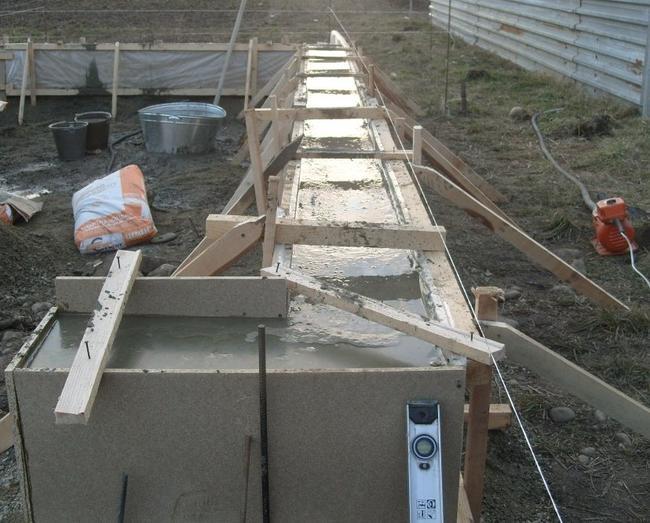
Foundation on dense soil
Without a doubt, it is no longer a secret that you can do without laying a foundation. Because the bearing capacity of the soil is twelve kilograms per square centimeter. Based on these numbers, it can be seen that the site will easily support the weight of any frame structure. If at the same time you prepare layers of heat and waterproofing, then the load-bearing beams can be laid on the ground itself.
Stages of formation of the earthen base:
- To begin with, it is worth digging a buried pit of twenty-five centimeters. This should be below the fertile layer. Next, we level the bottom of the pit until it is parallel to the ground surface.
- The next stage will be the installation of plank formwork over the entire area of the building, which will subsequently be considered the basis of the heap. A layer of clay is also placed on the bottom; the size should be about thirty centimeters.
- After some time, the clay hardens and becomes ready to accept and support the weight of the building. Before installing the frame, you should put roofing felt on the wall, and you should also take care of thermal insulation. Therefore, it is worth putting a moisture-resistant material, for example: expanded clay, this is what needs to be poured into the heap box.
The entire weight of the structure rests on the shoulders of the clay surface; in this case, expanded clay protects against heaving and freezing, and also serves as thermal insulation for the building. Since there are cracks in the expanded clay backfill, thanks to them, there is free circulation of air flow in the underground room.
Is it possible to build a house without a foundation?
Are there types of houses that can be built without a foundation?
One of the main requirements for building a house without a foundation is the presence of solid and non-flowing soil. Of course, in some cases this requirement can be neglected, but then the technology for building a house will be much more complicated.
There are a lot of options for building a house without a foundation, here are just some of the existing ones:
The frame is a relatively lightweight structure. A lot of houses have been built around the world using this technology. When building a house using frame technology, it is necessary to provide additional reinforcement of the structure, however, despite this, the work will still cost less than a classic foundation.
A very interesting solution is a foundation made of car tires. In this case, a pit no more than 40 cm deep is dug, a sand cushion about 20 cm thick and a gravel layer about 20 cm thick are laid on the bottom. Tires are laid on the gravel and then covered with sifted wet sand. A structure erected on such an alternative foundation should be small in size, but can last about 50 years.
This type of alternative foundation is used in areas with rocky soil and in mountainous areas. Houses built on boulders are quite stable; a stone foundation has a number of advantages of a conventional, classic foundation. This is a very cheap option for the foundation, since you don’t have to buy the material at all. Large stones are installed in the corners, as well as along the longest walls. Ventilation openings are provided, they are mounted from boards and covered with soil. Houses with such a foundation can last for many years, and the foundation itself does not lose any strength or rot.
There are houses that are built directly on the ground. To do this, it is necessary to make some preparations, namely, remove a small layer of earth, compact and lay a layer of clay on the bottom, it will perform the task of waterproofing. The frame itself is installed directly on the clay.
- brickwork instead of foundation
There is an option to make brickwork instead of a foundation. It is enough to make masonry from high-quality bricks. In fact, columns are erected that perform a load-bearing function.
Therefore, in answer to your question, we can confidently answer “Yes, building a house without a foundation is possible.” But how long such a house will last will depend on the type of soil and the quality of the work performed during the construction of such a house.
In individual housing construction, the foundation, as the independent foundation of a house, became widespread in the 60s of the last century. Previously, wooden houses were placed on the ground, on a leveled area. Rarely did they deepen one or three bottom rows into the ground.
As a rule, larch or oak was used for the lower rows of the log house. The number of lower rows of the log house, which, in fact, were the foundation in our view, depended on the financial capabilities of the owner of the household. If funds allowed, the cutting of the “foundation” could be about 2 m high, which made it possible to use the “ground floor”, for example, as utility rooms for household needs. In Irkutsk, Krasnoyarsk, Tomsk there are still old wooden houses, where the “ground floor” was previously used by the owners for trading (there were shops or taverns there).
Today there is technology for building houses from a variety of frame sandwiches. They can be safely placed on a well-prepared, waterproofed site without a foundation. Of course, there are nuances (freezing zone, embankment technology, wind erosion), but in principle, even in northern latitudes, houses are built without a foundation. An important condition is that the lower part of such a house must have reliable protection against freezing.
A brick house without a foundation after 40 years of operation. Results.
After I posted articles on the channel about my foundation, there was a barrage of criticism in the comments that the foundation was wrong, the tape should be buried, or the piles should be turned, etc. Well, and the apotheosis, as usual, “Why a frame house for mice, you need to build it out of brick”
. The reinforcement in my foundation is welded, but “it should have been knitted,” and stuff like that. I would like to tell you an interesting story about a brick house that was built simply without a foundation and stood for 40 years. In principle, it still stands, but is already being prepared for demolition.
Background
Our family has a dacha in which three generations have grown up. My grandfather built the dacha. He had a friend who, after his grandfather built a dacha for himself, also wanted a house next door. He was a man of a creative profession, and at the same time a representative of the Soviet nomenklatura, he did not know how to build himself, but he really wanted a dacha. Plus, he was also a very expressive person, that is, if he wanted something, he had to quickly make his nose bleed. The result of all this was a house next door to ours, which was built in 3 days. Moreover, according to the grandmother’s recollections, the walls themselves were built in a day.
What is the house itself like?
The house is brick, the wall is one and a half bricks. The size of the house itself is 6*6 meters, the second floor is an attic, not insulated. The trick is that there is no foundation under it. The fertile layer was removed from the ground and the trenches were filled with compacted sand. And this is a standard country house of that time, the windows are wooden, the inside is covered here and there with battens, some of the walls are simply plastered. The dacha was intended for summer living only. Because of this, the window is one glass. In the middle of the house there is a Russian stove, judging by the fact that it is all in cracks; under it, too, the foundation, if cast, is somewhat flimsy. The house itself was built in 1978. This year is his 40th anniversary.
Operation history
The first owners spent summer holidays in this house until 1989. In the first years of its life, the house did not cause any particular inconvenience, except that on the second floor the walls were covered with some kind of varnish, which constantly dripped in hot weather. I still remember that on the second floor they had chairs with small backs against the walls, and there was always the possibility of sitting incorrectly, leaning against the wall and sticking to them. Although there wasn't much of a varnish smell.
Why do you need a foundation?
At the very beginning, it is necessary to understand the purpose of the foundation; this will help determine the properties of the analogue of this part of the housing structure.
So, the foundation is needed:
- Firstly, to equalize the load projected onto the ground by the building. That is, any perfectly flat area will work no worse than a cast grillage.
- Secondly, to cut off moisture from the basement floor. This function can be achieved using reliable waterproofing.
- Thirdly, to level out heaving deformation. This role can be performed by any elastic layer that dampens soil vibrations. In addition, the soil under the house can simply be insulated, preventing both soil freezing and subsequent deformation of soil heaving.
- Fourthly, for ventilation of the basement of the building. This function can be completely discarded by impregnating the lower blocks and crowns with a solution that protects the building material from rotting.
As a result, building a house without a foundation involves replacing a cast, pile or slab foundation with a perfectly flat, waterproofed and insulated platform.
In terms of functionality, such a solution can compete with the classical foundation.
How to build a house without a foundation: a review of alternative technologies
In the previous paragraph, we figured out the functionality of the base of the house. In addition, we identified the requirements for an alternative foundation option. And now we are ready to offer our readers an overview of alternative solutions.
Tire foundation
The construction of such a foundation is carried out according to a very simple scheme, namely:
- First, a pit no more than 40 centimeters deep is opened at the construction site.
- Next, a sand cushion (20 centimeters thick) and a gravel layer (10-20 centimeters thick) are laid at the bottom of the pit.
- Regular car tires are laid on gravel. Moreover, the installation is carried out from the corners, in rows, filling not only the contour of the base, but also the inside of such a “foundation”
- After installation is completed, sifted, wet sand is poured into the inside of the tires and into the space between adjacent tires.
As a result, after filling all the internal “sins” of such a base, the frame of a prefabricated house or change house, or garage is mounted on it.
Moreover, such a frame house without a foundation, based essentially on tires, will last for at least half a century. After all, the sand and gravel cushion partially dampens the deformation of soil heaving.
And a layer of sand-reinforced tires works both as a damper, leveling the load, and as a waterproofing agent, retaining moisture. Well, the ventilation of the basement is ensured by the natural circulation of air blown through the cracks between the tires.
Boulder foundation
The construction of such a foundation is economically justified only in mountainous areas where ownerless rock fragments - boulders - are found.
Well, the foundation itself on boulders is built according to the following scheme:
- The contours of the future foundation are drawn on the surface of the construction site.
- Boulders are collected and sorted by size and stored near the construction site. Moreover, the largest stones are stored separately - they will be used to arrange the contours of the base.
- The process of assembling the foundation begins with digging a trench, at the bottom of which the largest boulders are placed. The next layers are formed from smaller stones. Natural stone masonry is secured with concrete or sand-clay filling.
- The beams of the structure's frame are laid on top of the largest stones, immersed in the ground in pre-marked places.
As a result, by assembling a tape from boulders fastened with cement or soil, you can obtain a foundation whose performance characteristics are comparable to those of a concrete monolith. Moreover, the heaving deformation is dampened by the heavy weight of large boulders, and the grillage is laid out from stones of smaller dimensions, poured into a pre-arranged pile . Ventilation of the base occurs through cracks in the masonry, and such a foundation does not need waterproofing - rocks conduct water very poorly and in mountainous areas they practically do not practice separate waterproofing of the foundation.
Strength gain
Concrete in a hardened state is an artificial stone obtained from a solution composed in certain proportions of cement, sand, gravel and water (composition of concrete for the foundation, proportions in buckets and kilograms). There is no clear answer to the question: how long should the foundation stand after pouring? Although any builder can name the average figure - 28 days.
But the process of gaining concrete strength is affected by:
- brand of cement (choosing a brand of concrete for the foundation of a private house);
- percentage of cement and water in the concrete mixture;
- weather conditions and air temperature.
The process of setting design strength characteristics can be divided into two stages:
- grasping;
- hardening.
Table of foundation strength gain.

Grasping
The concrete mixture remains in a liquid - or mobile - state for some time. This phase can be increased in time by constantly stirring the solution (on how to properly pour the foundation for a house). For this reason, concrete is delivered to construction sites in concrete mixers. Although this process also has a downside: if the mixture is left in the mixer for too long, its quality changes, and for the worse.
The setting period is directly dependent on the air temperature. For example, at zero temperature the setting process begins after 6-10 and ends after 15-20 hours after mixing the mixture.
Houses without foundation
The construction of buildings requires the presence of a foundation, a base that is responsible for the stability and fixation of load-bearing supports. Errors made when designing sites lead to deformation of wall partitions and ceilings, collapse, and constant costs for repairs and reconstruction. Today, the construction technology market is dominated by frame houses, which can be built directly on the ground.
Equipping a foundation is a costly procedure. Before starting site preparation, it is important to conduct geological research, establish the presence and nature of groundwater, and determine the type of soil. Not every territory is suitable for pile or strip foundations. This is due to the financial costs of preparatory work.
Houses without foundation
- it's practical. Most often, the base is an embankment consisting of sand, crushed stone and cement. This helps to create a kind of podium that protects the cottage from movement and soil changes, from floods and other vagaries of bad weather. Preparing the embankment is much easier. In addition, this does not require any research or the involvement of expensive specialists.
Among the advantages of houses without a foundation are:
- Minimum costs. The cost of constructing such a cottage is several times less than a brick or reinforced concrete one, for which the foundation is a prerequisite for safety. Therefore, everyone can afford such mansions.
- Construction in any season. You can build houses without a foundation both in summer and in winter. Temperature conditions do not matter. The embankment is easy to build on an area cleared of snow and ice.
- Reliable flood protection. A properly prepared base is invulnerable to water flow. The embankment raises the building above the ground and thereby prevents flooding of the basement. In addition, most often the ground floor in frame cottages is not meant at all.
- Variety of layouts. Houses without a foundation are an ideal option for those who want to get a cottage that is unlike others. Mansions can be built in any area. This may be an area remote from water or a coastal zone. The absence of a complex foundation structure eliminates restrictions in terms of the area and shape of premises and the location of load-bearing supports.
- Speed of construction. Preparing the foundation is a lengthy process that often takes several weeks. In the future, you will have to spend time waiting for the shrinkage that occurs with both tape and pile platforms.
How long should the foundation settle?
The deadlines specified in the standards for the concrete structure to be able to withstand do not always correspond to real time. They are influenced by extraneous factors, such as:
- ambient temperature;
- humidity conditions;
- presence of precipitation;
- season;
- ground conditions;
- terrain;
- dimensions and type of foundation - strip, slab, columnar;
- design strength of concrete;
- quality of materials;
- presence of groundwater on the site;
- construction technology;
- presence of additives;
- magnitude of design loads.
In addition to the above points, situations may arise that affect the period during which the foundation of the house will have to settle before further work begins. In some cases, the concrete structure is left even for the winter, so that when the soil thaws it is easier to identify defects and correct shrinkage. At the same time, the monolith is securely covered. It is noteworthy that no standard can take into account all the nuances, so the question of how long the foundation of the house will be defended is decided on an individual basis.
When determining timing, the worst case conditions for the site should be assumed. The stock, in this case, will play a positive role.
Why frame houses?
Frame technology is a long-lasting trend in Europe and America. The costs of preparing buildings are minimal. This is much more profitable than buying an apartment in the city. Frame technology is adapted to climate change, which means it is optimally suited for the changeable Russian climate. Turnkey frame houses can be built during the winter frost season and within a few months you will have a building fully equipped for living.
The key advantage of frames is proper weight distribution. Regardless of the number of rooms, the weight load on the supports is distributed harmoniously. That is why there is no need to build a massive foundation, spend money on purchasing reinforced concrete blocks and renting special equipment for digging a pit. Even an ordinary embankment, which consists of sand, crushed stone and cement, can fix and hold reinforcement and metal supports.
Hardening time
You can try to calculate how long the strip foundation should stand. It will not be possible to begin construction of walls and other structures earlier than three weeks after pouring. And this is provided that the weather outside was sunny and without precipitation for the next few days. It is forbidden to disturb a foundation that has not yet hardened and which has not had time to stand properly. This usually happens when builders want to fix something. Such interference should not be allowed. The foundation should harden within one month. At the same time, its shrinkage occurs. But even after so many days, there is no guarantee that the foundation for the house is completely ready for further use. After all, she will continue to shrink for at least a year. It will be possible to say how long the foundation should last only after it has been poured, as well as the installation of walls and other structures. But you shouldn’t draw hasty conclusions. The loaded foundation will stand for several months. During the year, various kinds of changes may occur to it, and shifts from its place are not excluded. It is almost impossible to predict them. This is one of the reasons why experts recommend that residents move into a newly built house only a year after its completion. If the owners of the future home do not need to build a house in a short time, then they should focus on the maximum length of time during which the foundation must settle. Lack of haste will protect the building from unpleasant consequences. The time limit can be shortened only in emergency situations. In any case, the foundation for a residential building must stand for at least two weeks before the builders continue to work on the construction of the building.
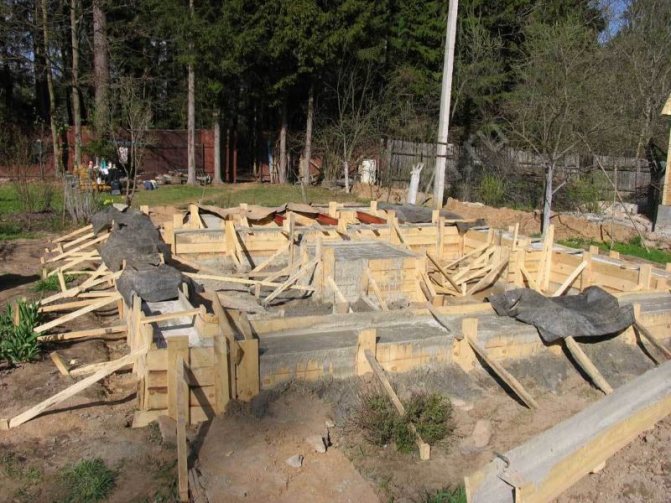
What designs of houses without a foundation exist?
You can get information about what types of frame houses there are, projects, photos and prices of these sites on the website of professional construction organizations. A competent company offers both a set of ready-made templates and layouts, and also works on individual orders. This is important when a building is being erected in a limited area, where it is necessary to fit a large number of rooms, but at the same time, correctly fit the structure into the composition of the garden plot.
A cottage without a foundation is much easier to modernize. We are talking about extensions in the form of verandas and gazebos. Thanks to this, you can continue the embankment or build a regular platform, which will not put an additional load on the foundation supports. This helps to create unusual solutions and implement bold architectural ideas.
When creating projects for houses without a foundation, special attention is paid to the engineering system. In such a situation, water and sewer lines are either taken outside or isolated directly under the house. This prevents serious repair costs in the event of a break or deformation of sewer pipes, which also speaks in favor of building frame houses without a foundation.
Foundation for an old house without a foundation: do-it-yourself video, photo
How to make a foundation for an old house without a foundation
Very often, owners of old houses are faced with trouble, which can be briefly described in a few words - “the house is cracking.” This means it’s time to repair the foundation or make it from scratch, if there is none.
Before you make the final decision about making a new foundation for an old house with your own hands, you should keep in mind that you will need a lot of effort and care. In this case, you will have to tinker quite a bit.

